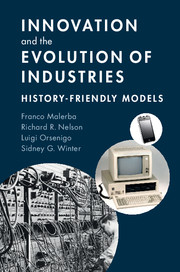Book contents
- Frontmatter
- Contents
- List of figures
- List of tables
- Preface and acknowledgments
- Codes
- Some remarks about notation
- 1 Innovation and industrial evolution
- 2 History-friendly models: methods and fundamentals
- 3 The US computer industry and the dynamics of concentration
- 4 Vertical integration and dis-integration in the computer industry
- 5 The pharmaceutical industry and the role of demand
- 6 Reprise and conclusions
- References
- Author index
- Subject index
6 - Reprise and conclusions
Published online by Cambridge University Press: 05 August 2016
- Frontmatter
- Contents
- List of figures
- List of tables
- Preface and acknowledgments
- Codes
- Some remarks about notation
- 1 Innovation and industrial evolution
- 2 History-friendly models: methods and fundamentals
- 3 The US computer industry and the dynamics of concentration
- 4 Vertical integration and dis-integration in the computer industry
- 5 The pharmaceutical industry and the role of demand
- 6 Reprise and conclusions
- References
- Author index
- Subject index
Summary
INTRODUCTION
As we reach the end of our explorations, it is instructive to look back at the assessment of formal modeling that Alfred Marshall offered many years ago:
It would be possible to extend the scope of such systems of equations as we have been considering … But while a mathematical illustration of the mode of action of a definite set of causes may be complete in itself, and strictly accurate within its clearly defined limits, it is otherwise with any attempt to grasp the whole of a complex problem of real life, or even any considerable part of it, in a series of equations. For many important considerations, especially those connected with the manifold influences of the element of time, do not lend themselves to mathematical expression; they must either be omitted altogether, or clipped and pruned till they resemble the conventional birds and animals of decorative art. And hence arises a tendency to assigning wrong portions to economic forces; those elements being most emphasized which lend themselves most easily to analytical methods.
(Marshall, 1890[1920], p. 850)We have been concerned in this book with grasping the decidedly complex real-life problems of innovation and industrial evolution. We have sought to capture in our dynamic models at least some of those “manifold influences of the element of time” of which Marshall spoke – though, of course, we do not make much progress on the full list. In choosing the “influences” to emphasize, we have tried in particular to bring to the fore the mechanisms that shape outcomes in ways that, while highlighted in many appreciative accounts of technological and industrial dynamics, are quite often ignored in highly stylized, static models. These are mechanisms that, first of all, take some time to operate. They also tend to involve substantial momentum effects, and path dependence. That our models reflect those mechanisms and aspects forms the foundation of their claim to being called “history-friendly models.” They portray the dynamic features of real economic causation, as described in empirical studies.
The constraints on mathematical analysis have obviously been relaxed a good deal since Marshall was turning out the successive editions of his Principles, roughly a century ago.
- Type
- Chapter
- Information
- Innovation and the Evolution of IndustriesHistory-Friendly Models, pp. 217 - 247Publisher: Cambridge University PressPrint publication year: 2016

